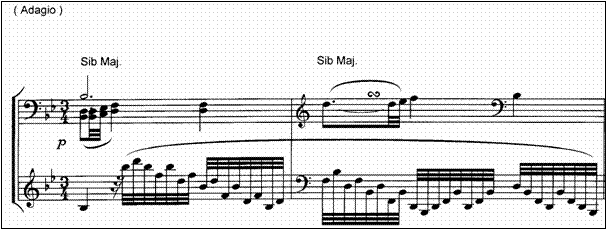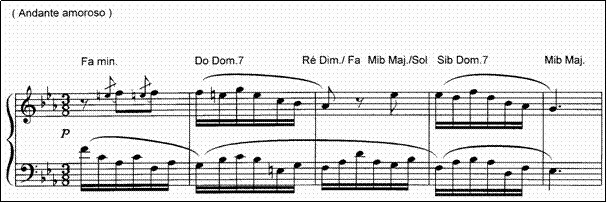1. Exemples et analyses
a. Sonata opus 31 N°2 - Adagio in Bb major ( L.V. Beethoven )

The left hand accompaniment plays a long broken arpeggio in thirty second notes, placed above the right hand theme (1st bar), just before coming back in a bass clef (2nd bar)
The arpeggio is based on the 3 main notes of a Bb major triad (Bb - D - F).
This example clearly shows the desire of space in beethoven's composition
b. Choral, variations and fugato / 2nd variation in C minor ( Y. Feger )

The broken arpeggio of this accompaniment is placed on the right hand with eighth notes triplets.
The left hand has a theme with eighth notes and gives the basses of the chords on each beat ( G - A - B - C), and also provides the harmony with an ascending arpeggio of 3 eighth notes.
The "3 VS 2" le-rythme produces a original floating le-rythme .
Beats 1 & 7 show very well the complementary harmony. The notes minor 7th and 9th are situated in the accompaniment.
c. Sonata N°3 / Andante in Eb major ( W.A. Mozart )

The left hand broken arpeggio supports the right hand melody which alternates 2 eighth notes and 6 sixteenth notes.
Bars 2 & 4 also give a good harmonic complement between the theme and the accompaniment. The vertical and simultaneous voices create some interesting dissonances that clearly shows the nature of the chords.
d. 24th prelude opus 28 in D minor ( F. Chopin )

The left hand accompaniment with broken arpeggios, is presented with a regular le-rythme of 4 sixteenth notes + 1 eight note, and an interval leap of 12th (D / A ) at the end of each beat.
This "pedal" arpeggio uses no more than a D minor triad in open position (D - A - F).
The right hand theme is also built on the D minor chord, with longer values.